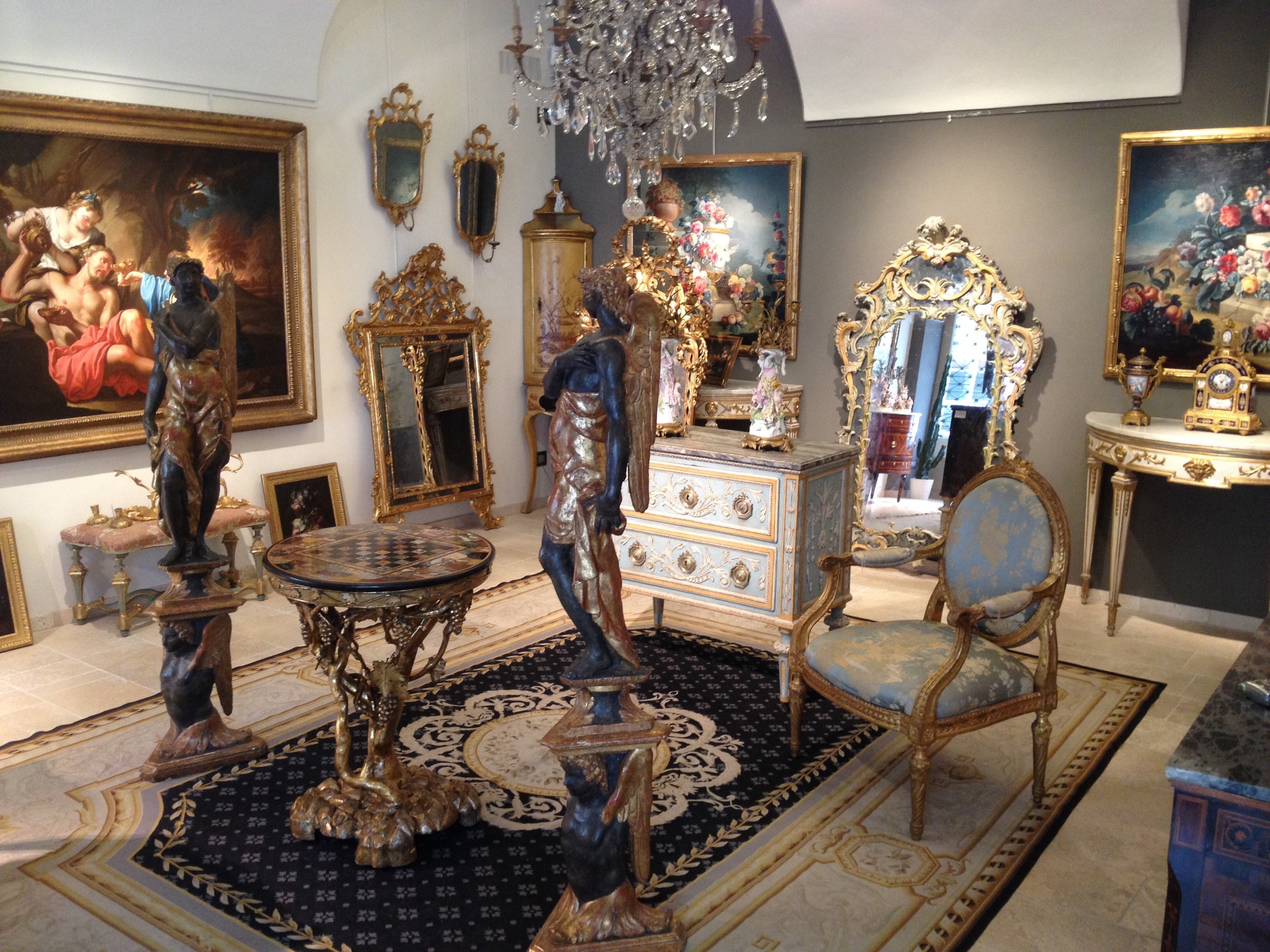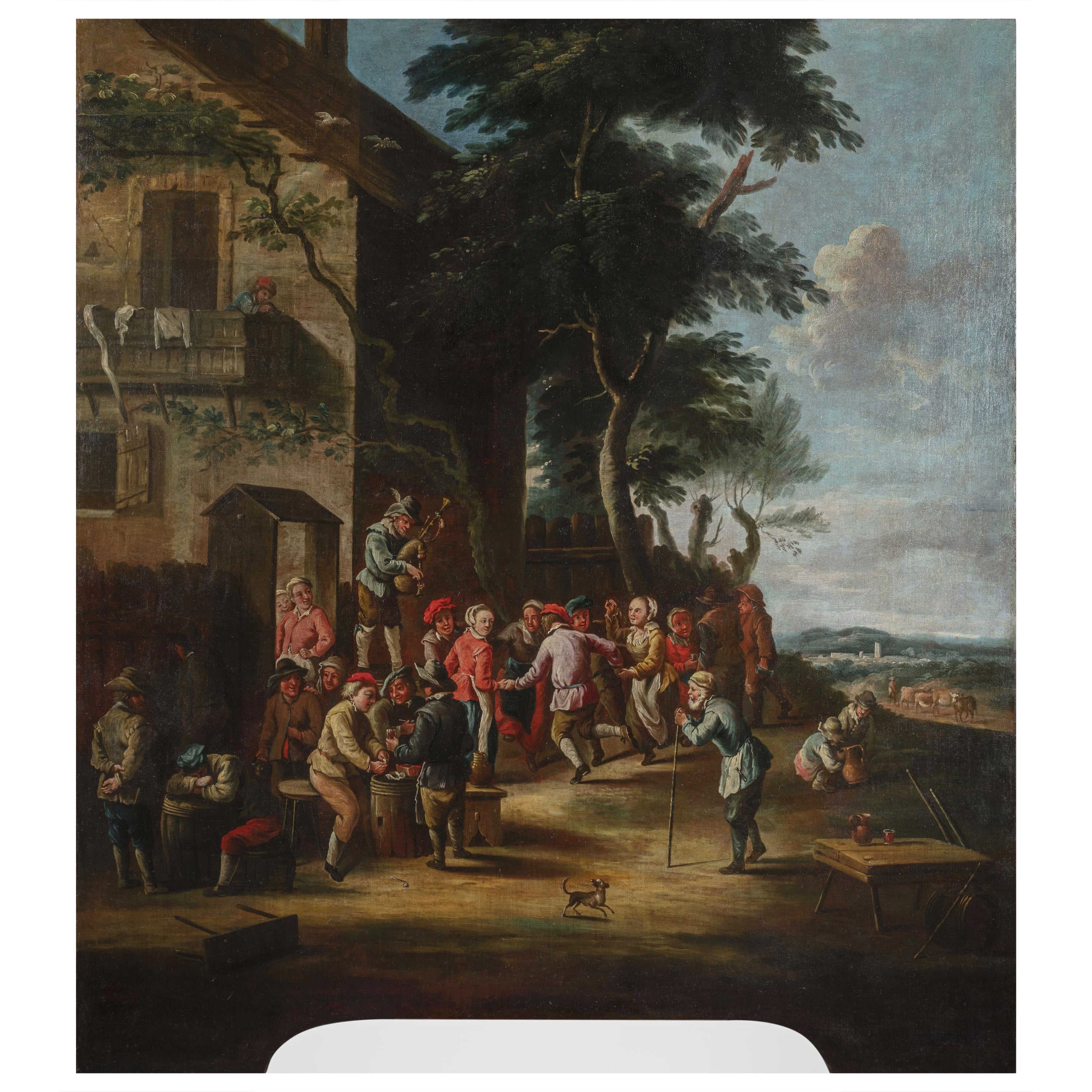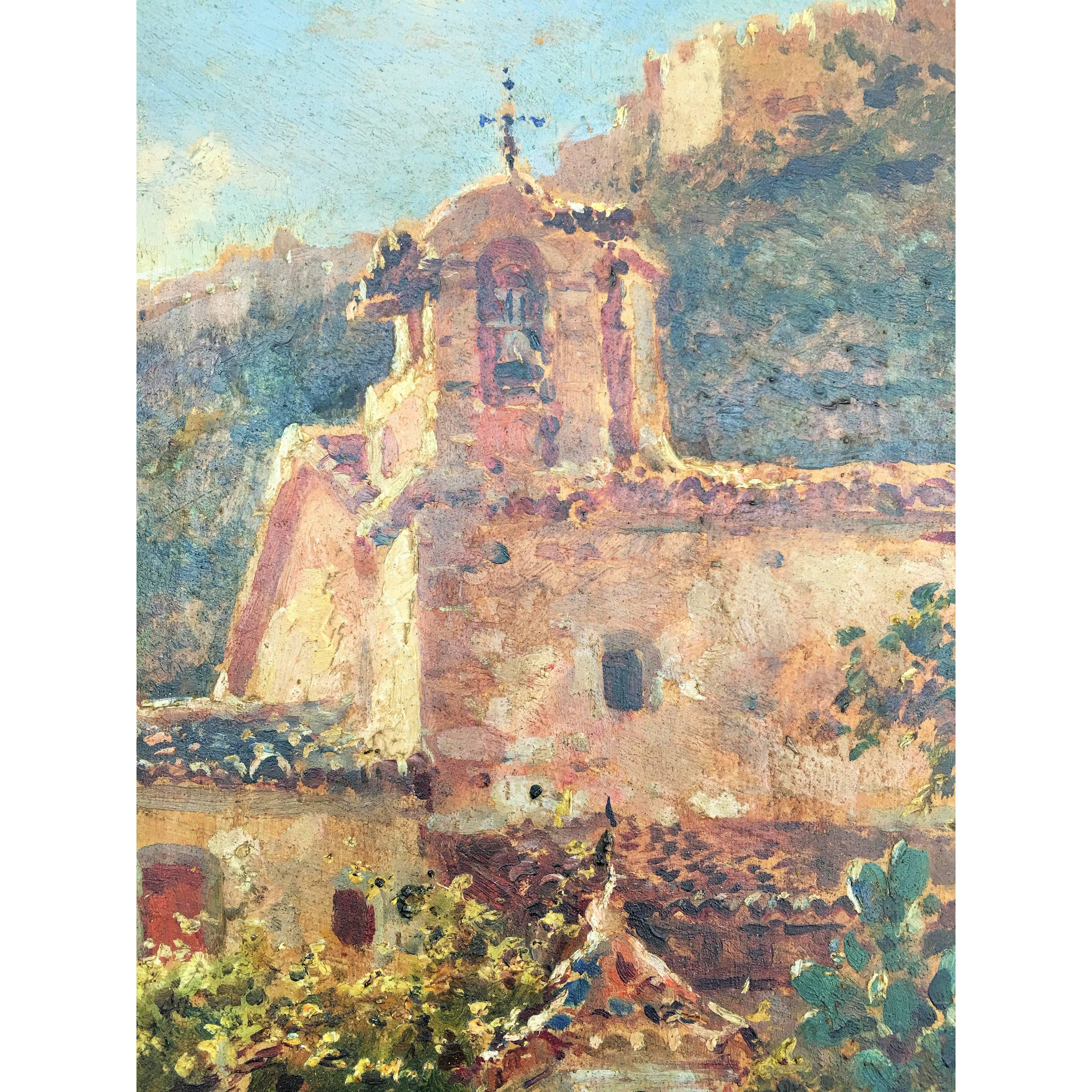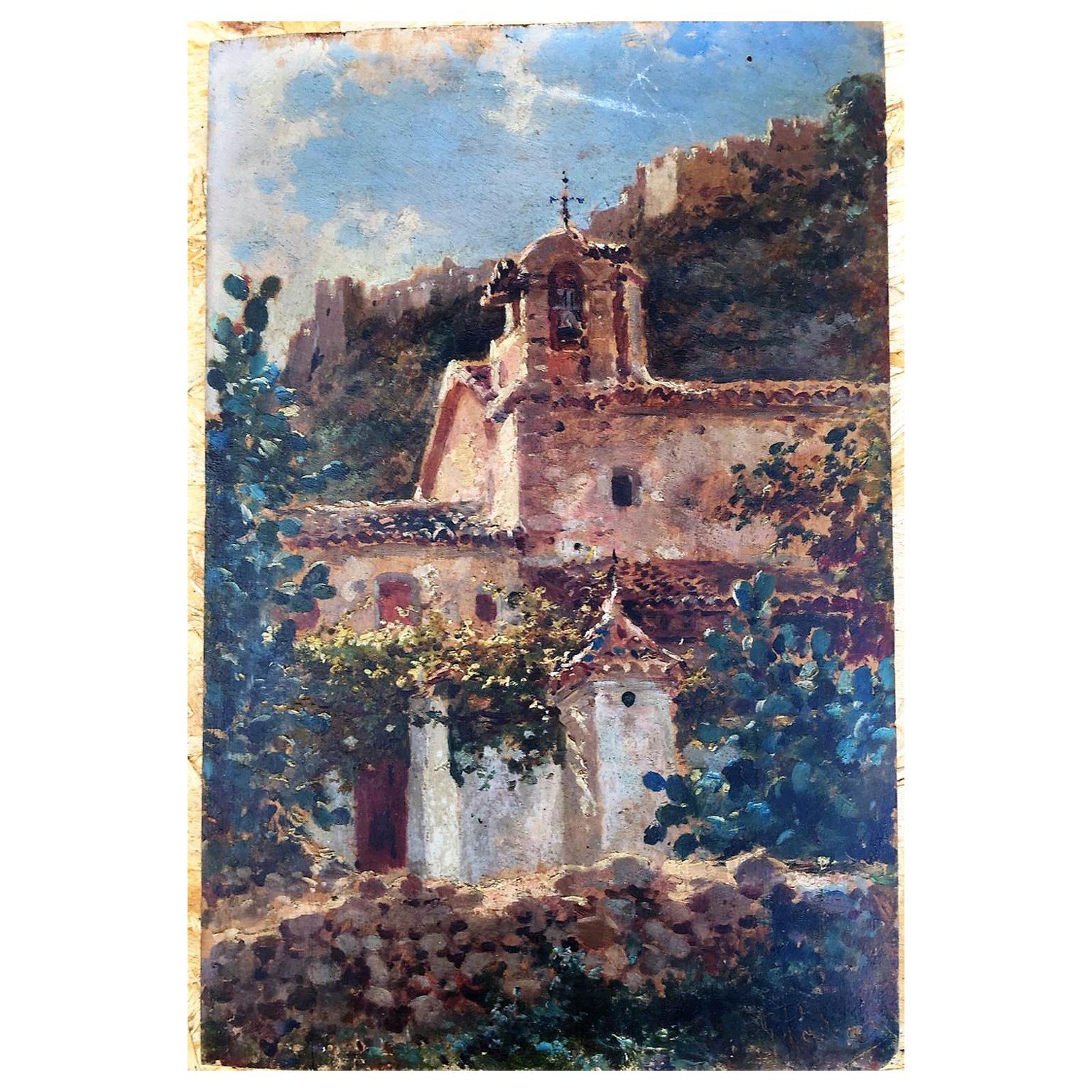Items Similar to 18th Century Italian Oil on Panel Bambocciata by Jean Miel Follower
Want more images or videos?
Request additional images or videos from the seller
1 of 15
18th Century Italian Oil on Panel Bambocciata by Jean Miel Follower
About the Item
Jan Miel (follower of)
The bambocciante scene
Oil on panel , cm 38,5 x 51. frame 66 x 53,5 x 4,5 cm
The bright painting, with great chromatic impact thanks to the technique of oil on panel represents a lively bambocciante scene, whose characters are located in a countryside, near the entrance door of a town or a village. With the term bambocciata are called the kind of painting aimed at representing, with figurative vivacity and animated effects of light and color, episodes of urban and rural life, street scenes, taverns, market, animated by people, gypsies and peasants. This subject spread especially in the 17th century, in open contrast with the great official baroque painting, and was thus called by the nickname “bamboccio” given to the Dutch painter Pieter van Laer, who worked in Rome in the first half of the 17th century.
The scene here depicted with great vitality, through the use of quick touches and textures of color, illustrates a moment of everyday life related to rural activity: on the right is painted, at the gates of the village, a cart loaded with hay that two farmers are setting up. Before them sit some figures who stand beside their horses. A woman on his horse reaches a passer-by while a shepherd walks behind him with his dog. On the left, a child is sitting on his back, playing with small dogs next to a horse that rests seated. The entrance to the village is characterized by an arched passage between ancient walls, described with poetic “rovinismo”, in addition to which there are some houses. The clear sky is marked by some grey white clouds.
The painting shows a close relationship between the composition and the famous paintings by Jan miel (Antwerp 1599 - Turin 1663). Born in Beveren-Waas near Antwerp, Miel was trained at home, perhaps at the workshop of Gérard Seghers and then Anton Van Dyck. In 1636 he was documented in Rome (Italy) and in 1648 he joined the Accademia di San Luca, of which he became Prior in 1661. After the frescoes now lost in Santa Teresa at the waterfront painted for the Barberini, he completed the pictorial cycles in the churches of San Martino ai Monti, Santa Maria dell'Anima and San Lorenzo in Lucina and participates in the important decorative enterprise of the Gallery of Pope Alexander VII Chigi in the Palazzo del Quirinale. To the production of cultured painter of history, he added that of the "bambocciate", considered his best works and often confused with those of Pieter Van Laer and Michelangelo Cerquozzi, and also collaborating with painters of architecture, such as Alessandro Salucci and Viviano Codazzi.
At the end of 1658 Miel moved to Turin in the north of Italy at the invitation of Duke Charles Emmanuel II. His art was already known in Piedmont, since 1651, thanks to the “Madonna that presents the Child to San’Antonio da Padova”, created for the cathedral of Chieri. Thanks to the prestigious Roman credentials, in the city of Savoy he was responsible for the decoration of the Royal Palace and the Reggia di Venaria, then under construction. For Venaria he received the order to fresco the vault of Diana’s hall (1661 1663) and to provide for the walls the canvas with the equestrian portrait of Adelaide and Ferdinando Maria elector of Bavaria (now in the Castle of Racconigi) and the ten hunts preserved today at the Civic Museum of Ancient Art of Palazzo Madama in Turin (1659 1661). The ducal commission also concerns the City Palace, where the Miel performs the plafonds of the Throne Room (Peace dominates the warrior furor) and of the Council Hall, already alcove (Sleep of Hannibal) and of the alcove (Clodoveo receives the sign of the lily) in addition to numerous overalls, then removed in the following outfits and not all of which have been traced.
The work is signed with a monogram M.C. (?) at the bottom right. The author of this painting will be sought after among the painters followers of Jan Miel, active in the 18th century. Some typical characteristics of the master’s bambocciate, both compositive and stylistic, can be recognized, such as the writing and the physiognomic typologies of his mature production. The painter describes with care the different protagonists, their gestures and garments; attention that indicates a study from the true of everyday life, read and interpreted with naturalism. The brush stroke is quick and easy, and the author is able, through the highlights, to render volumes and depths.
Historical and artistic studies are being carried out with a view to outlining more clearly the figure of the author.
- Dimensions:Height: 21.26 in (54 cm)Width: 25.99 in (66 cm)Depth: 1.97 in (5 cm)
- Style:Rococo (In the Style Of)
- Materials and Techniques:
- Place of Origin:
- Period:
- Date of Manufacture:18th Century
- Condition:
- Seller Location:IT
- Reference Number:1stDibs: LU4405217793742

About the Seller
5.0
Gold Seller
These expertly vetted sellers are highly rated and consistently exceed customer expectations.
Established in 1980
1stDibs seller since 2019
41 sales on 1stDibs
Typical response time: 1 hour
- ShippingRetrieving quote...Ships From: Italy
- Return PolicyA return for this item may be initiated within 7 days of delivery.
More From This SellerView All
- 18th Century, Italian painting Depicts Bambocciata by Giovanni Michele GraneriLocated in ITGiovanni Michele Graneri (Italy, Turin 1708-1762) Bambocciata (Farmers dancing in front of the inn) The painting, made in oil on canvas, depicts a moment of celebration where some p...Category
Antique Mid-18th Century Italian Baroque Paintings
MaterialsCanvas
- 18th Century, Italian Oil on Canvas Still Life by Pietro NavarraLocated in IT18th century, Italian oil on canvas still life by Pietro Navarra Oil on canvas, canvas measures: cm H 103 x W 164, framed measures...Category
Antique 18th Century Italian Baroque Paintings
MaterialsCanvas
- 18th Century, Italian Pair of Oil on Canvas Paintings by Francesco SimoniniBy SIMONINILocated in ITFrancesco Simonini (Parma, 16 June 1686 - Parma, 1766) “The rest of the soldiers” and “The march of soldiers” oil on canvas The very fine paintings, attributable to the painte...Category
Antique Early 18th Century Italian Baroque Paintings
MaterialsCanvas
- 18th Century Italian Oil on Canvas Painting with Battle by Antonio CalzaBy Antonio CalzaLocated in ITAntonio Calza (Italy, Verona, 1653-18th April 1725) "Battle between Christian and Turkish cavalry with castle" The painting depicts a bloody battle between Christian and Turkish cavalry. Characterized by dynamism, intensity of color and light, the main scene occupies the lower horizontal section of the canvas, optically interrupted by the black fumes of the shots from which emerge, on the left, the towers of a fortress. On the right, in the distance you can see the combat in progress in the countryside, beyond which you can see the pale presence of hills that create a fifth, marking the horizon. To frame the scene contributes to the left, against light and in the foreground, a portion of the wall. The painter, however, introduces a horse on the ground, of which we see only the back, a ruse to involve the observer making him become active and participate in the scene. In the foreground, lifeless bodies, wounded horses and, scattered on the ground, weapons and a drum enhance the drama of the clash. The excitement and expressive force, the intense chromatic range attentive to the conditions of light and the fine brushstrokes, decisive and dramatic, suggests the attribution to Antonio Calza, one of the most important painters of battles of the seventeenth century, excellent student and continuator of the greatest interpreter of the genre, Jacques Courtois called il Borgognone (Saint-Hyppolite 1621 - Rome 1676). Il Borgognone, although not having had a real school or direct students, places itself as a primary reference point by the Italian and foreign "battaglisti". The genre of battle painting found great success in the collections of the Italian and European nobility of the seventeenth and eighteenth centuries. The battles of the Italian Renaissance, in which the scene converged towards a precise protagonist, evolve towards a type of combat "without hero". The bloody realism of the details and the dynamic development of the narrative confuse the figure of the protagonist, when present, to give importance to the swirl of horses and armed fighters, among which, moreover, does not emerge a winner. The certain documents relating to the life and movements of Antonio Calza are scarce; it was equally difficult to reconstruct, from the critics, a catalogue of autograph works. Through paintings in private collections, in museums and paintings passed on the antiques market it has been possible to identify a copious corpus of works that can be traced back to his hand. The work of art historians, together with that of antique dealers, in conferring proper attributions in order to best outline the figure of Calza, continues but studies are still in progress. In this sense, the work of Giancarlo Sestieri should certainly be noted, who investigated the artistic production of the battaglisti and Calza, thus allowing the comparison of the numerous photographic works reported, to identify and recognize the stylistic qualities that distinguish the corpus of paintings assigned to him today. Antonio Calza was born in 1653 in Italy, in Verona and in 1664 he entered the school of Carlo Cignani in Bologna, dedicating himself to painting battles and landscapes. He then perfected in Rome, where he knew the works of the then undisputed head of the sector, Jacques Courtois called the Burgundian. In 1675 he returned to Verona and married an 88-year-old widow who, dying, left him a rich inheritance. Much appreciated by the nobility and the bourgeoisie, he received numerous commissions. Bartolomeo Dal Pozzo (Le Vite de' pittori, de gli scultori et architetti veronesi, 1718) praises "three great paintings of battles...Category
Antique Late 17th Century Italian Baroque Paintings
MaterialsCanvas
- 18th Century, Italian Oil on Canvas Painting with Landscape with RuinsLocated in IT18th century, Italian oil on canvas painting with landscape with ruins Measures: only the canvas cm W 97.5 x H 108; with the frame cm W 103.5 x H 114 x D 5 The fine oil on canv...Category
Antique 18th Century Italian Baroque Paintings
MaterialsCanvas
- 19th Century Four Italian Oil on Panel with Allegory of the Four ElementsLocated in IT19th century four Italian oil on panel with allegory of the four elements Dimensions with frame: cm H 34.5 x L 25; only the table: cm H 29 x L 20.5 The funny oil on panel, by an artist active in Piedmont, in the north of Ital, in the first half of the 19th century, represent the allegory of the four elements of the Earth. They are inspired by the group of four etching prints of circa 1730, made to a design by Rococo painter Jacopo Amigoni (Naples 1682- Paris 1752) and engraved in Venice by Joseph Wagner...Category
Antique 19th Century Italian Rococo Paintings
MaterialsWood
You May Also Like
- 18th Century Sanctuary Oil on PanelLocated in Miami, FL18th century sanctuary oil on panel The Roman Sanctuary of the Felix father in Jativa, Valence, Spain.Category
Antique Late 18th Century Spanish Baroque Paintings
MaterialsWood
- 18th Century French Firescreen-Painted Oil on Cancas, Wood PanelLocated in New Orleans, LAOriginally an 18th century French firescreen with a musical motif painted in oil on canvas fixed to a wooden panel.Category
Antique Late 18th Century French Rococo Paintings
MaterialsCanvas, Wood
- European School Oil on Panel of the 18th CenturyBy EuropaLocated in Madrid, ESEuropean School oil on panel of the 18th century Measures: 34X24CM Good condition.Category
Antique 18th Century German Baroque Paintings
MaterialsPaint
- 18th Century Baroque Sanctuary Oil on Wood Panel, SpainLocated in Miami, FL18th century sanctuary oil on panel The Roman Sanctuary of the Felix father in Jativa, Valence, Spain.Category
Antique Late 18th Century Spanish Baroque Paintings
MaterialsWood
- 18th Century Oil on Canvas Italian SchoolBy Carlo MarattaLocated in Marseille, FRPainting with probably biblical Italian school characters End of the 17th beginning of the 18th century unsigned carrying a Carlo Maratta cartouche of in...Category
Antique Early 18th Century Italian Baroque Paintings
MaterialsCanvas
- 18th Century Italian Wood Painted PanelLocated in Firenze, FINice wooden panel painted with geometric decorations, figures and fantastic animals, probably used to hide niches in the wall or as a decorative element on the door jamb. Typical Mar...Category
Antique 1720s Italian Louis XIV Paintings
MaterialsPine
Recently Viewed
View AllMore Ways To Browse
Arched Panel Doors
Wall Panel Door
18th Century Painted Wood Panels
Wall Cabinet Paneled
White Wood Wall Panels
18th Century Painting Dutch
18th Century Dutch Paintings
17th And 18th Century Oil Paintings
18th Century Dutch Frame
Rococo Panel Painted
Rococo 17th Century Furniture
Baroque Panels Italy
Baroque Painted Panel
18th Century Oil Paintings Small
Antique Wood Furniture Care
Cabinet Door Wall Panel
18th C Dutch
Wood Horse Stand





